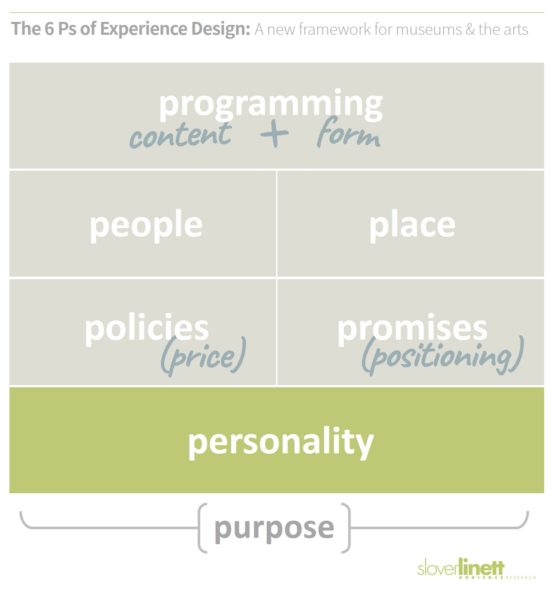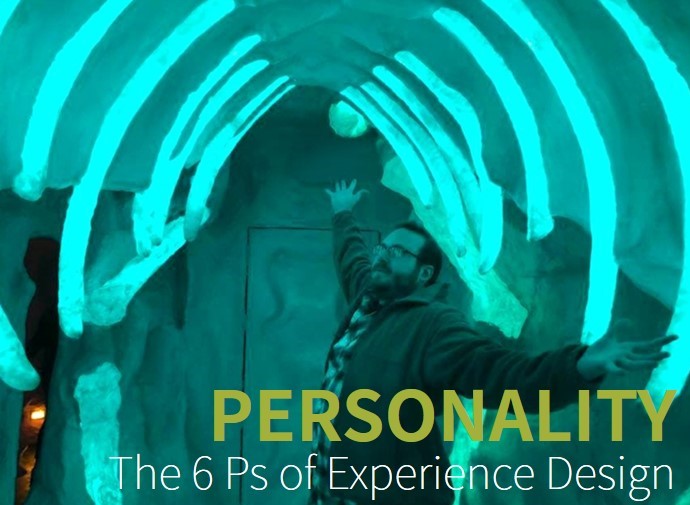News & Notes
The unifying sensibility: Personality (6 Ps of Experience Design)
This is the eighth in a series of posts about our new framework for cultural engagement, The 6 Ps of Experience Design. If you haven’t read the preceding posts, you may want to start at the beginning.
- Policies
- Promises
- Personality [this post]
- Bonus “P”: Purpose
How often do you and your colleagues talk about the personality you’re trying to embody for your community and audiences?
 When you do, do you use that term strictly in the context of marketing and branding, or also when you’re developing programming, doing strategic planning, designing a new building, updating policies, hiring colleagues, and forging partnerships with other organizations?
When you do, do you use that term strictly in the context of marketing and branding, or also when you’re developing programming, doing strategic planning, designing a new building, updating policies, hiring colleagues, and forging partnerships with other organizations?
Most museum and arts professionals think of personality as something that enlivens and humanizes an organization’s brand, a flavoring to be added to the message. Few treat it as a unifying principle of experience design. Yet this last P in our framework is perhaps the most important one, because culture is a human, social activity and personality is one of the defining — if hard to define — characteristics of human interaction.
In our research with cultural institutions and funders, we’ve come to think of personality as the underlying spirit, attitude, mood, vibe, and sense of humor (or lack of it) of the organization, program, or experience. It’s actually easier to study than to define: In research, we often ask audiences to imagine the organization or program as a person, then describe what it would be like to meet that person at a party. Or tell us what sort of relationship they currently have with the (personified) institution. Of course, the answers vary depending on whom we ask (loyal subscribers or non-attenders), but they’re always revealing and sometimes emotionally laden. Rarely are they derived solely or even largely from marketing communications or logos, though those can play an important role. They’re usually based on past experiences with the organization’s programming, people, place, policies, etc. — in other words, with the experiences it offers. (For those who don’t attend, of course, the sense of personality is based more on ambient perceptions and sometimes assumptions about the cultural category in general: opera, science museums, botanic gardens, etc.)
Next time you’re planning a performance series, exhibition, or new facility, ask yourself what personality traits should infuse and unify all aspects of the experience. What sensibility should come through for the visitor or ticket-buyer? How should the experience feel? What’s the tone, the “voice” behind the decisions and designs? There’s no right answer to these questions, but many of our clients — and many of their audiences — want the personality to be warm, welcoming, enthusiastic and passionate, confident, generous, empathetic, and sincere. They want it not to be pedantic, dry, withholding, self-serious, or snobby. (I’m generalizing here, the priorities vary widely by context and cultural domain.)
What about sense of humor? With a few exceptions, we don’t usually associate that personality trait with institutional arts and culture. Sure, some of the plays on nonprofit theater stages are comedies, and some of the work in contemporary art museums uses humor. But the organizations themselves — artistic directors, executive directors, curators, exhibition designers, educators, customer service VPs, advancement officers — tend not to think about, much less strategically use humor in their work. Yet laughter is a universal human currency, a powerful tool for creating a sense of community, lowering defenses, increasing receptivity to new ideas, even creating conditions for empathy — all things that cultural organizations hope to do.
One of those exceptions is science engagement, not the hands-on museum kind but live events like Nerd Nite, which takes place at bars in cities around the world, and the edgy science comedy and science storytelling shows at Caveat in New York City. There are some important lessons here for the rest of the cultural sector about not taking yourself too seriously, even when the content is seriously important.
As I said about all the Ps in the overview, not being conscious and intentional about personality doesn’t make it go away: your decisions would still convey a personality, though it probably wouldn’t be a particularly appealing or memorable one. And you’d be missing an important strategic tool for creating successful, relevant cultural experiences.
All of which is why discussing personality shouldn’t be relegated to a rebranding exercise. It ought to be a key step in strategic planning, architectural planning, employee recruitment and training, and of course holistic experience design at the institutional or program-specific level.
* * *
With personality, we’ve come to the end of the core framework. But there’s one more P to consider, as a bonus or bellwether: the emerging question of purpose. Read the final post in the series…
Photo: Another Meow Wolf photo (forgive our enthusiasm) taken by Ashley Ann Wolfe.

